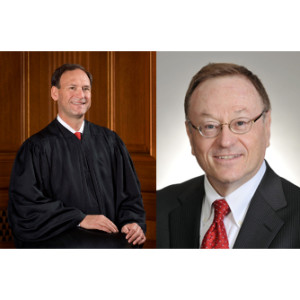Response by Professor Roger Schechter | Geo. Wash. L. Rev. Docket (Oct. Term 2014)
B&B Hardware, Inc. v. Hargis Industries, Inc., 575 U.S. ___ (2015) | Docket No. 13-352; argued decided March 24, 2015
Slip Opinion | NY Times | SCOTUSblog
Ever since the adoption of the Lanham Act in 1946,1 the relationship between the federal trademark registration system on the one hand, and the general common law of trademarks on the other, has been murky. Certain marks can be eligible for federal registration before they have earned protection under state common law.2 Other marks might be barred from federal registration3 but still entitled to protection against infringement in a suit under state law or under the Lanham Act’s general unfair competition provision.4
One consequence of this stereoscopic approach to American trademark law has been that senior users of a particular mark sometimes must litigate twice when another party selects a similar mark for similar goods. First, if that junior user attempts to register its mark, the senior party will usually oppose the registration (in an administrative proceeding before the Trademark Trial and Appeal Board or TTAB). Such oppositions are grounded on section 2(d) of the Lanhan Act,5 which requires the opposer to show that registration of the junior user’s mark would cause an impermissible likelihood of confusion. If the opposer is sucessful, however, that only means that the junior user is denied registration and its associated benefits. To prevent the junior user’s continued use of the problematic mark in actual commerce, the senior user must then sue for infringement—usually in federal district court—and convince a judge or jury that continued use of the disputed mark would likely confuse an appreciable number or relevant consumers.
This situation set the stage for the recent decision in B&B Hardware v. Hargis, in which the Supreme Court held that a junior user who has lost before the TTAB may be precluded from relitigating the likelihood of confusion issue in a later infringement suit in some, but not necessarily in all cases.6 The doctrine of “issue preclusion” is normally justified in large part on the basis of judicial economy, because it prevents constant revisiting of issues once they have been judicially resolved. Ironically, however, in the context of trademark practice, B&B Hardware may have the opposite result.
The prospect that an adverse TTAB ruling may effectively amount to a finding of infringement means that the stakes for the junior user at the Trademark Office are vastly greater than they were before B&B Hardware. The Eighth Circuit in this case had taken the view that the decision of the TTAB could never foreclose relitigation of the confusion issue in the later infringement suit. On that view, an adverse administrative ruling did not preclude the junior user’s continued use of the mark unless the senior user opted to sue for infringement, established likelihood of confusion on a full record in that suit, and was able to convince the court to grant an injunction. This approach allowed both parties to take a breath and see how things played out in the real world marketplace before investing huge resources in full-fledged litigation.
Now, however, the prudent junior user must assume that an adverse ruling from the TTAB will be tantamount to an injunction against all further use. While Justice Alito writing for the Court in B&B Hardware cautioned that “for a great many registration decisions issue preclusion obviously will not apply because the ordinary elements will not be met,” it is impossible to know in advance whether any given district court judge will treat a TTAB finding on the confusion question as dispositive. This could turn administrative disputes at the TTAB into “bet the company” life-or-death struggles.7
One likely result of the higher stakes is that proceedings before the TTAB could become longer, more complicated and more expensive, and there may be more of them. Unsure of whether the result will be preclusive in subsequent infringement litigation, both sides may attempt to offer all of the types of evidence that they would normally only muster in an infringement suit, such as an elaborate and expensive consumer survey. It is too soon to know if the TTAB is capable of handling a larger volume of much more complex cases that the B&B Hardware opinion may bring its way.
To be sure, greater complexity at the TTAB is not inevitable. The TTAB often stays the administrative opposition case as soon as civil litigation is filed.8 The procedural history in B&B Hardware was quite unusual, making it the rather rare case where the TTAB ruling on the opposition to registration came before the conclusion of the infringement suit in district court. Continuation of the historical practice regarding stays would mean that very little would change in either TTAB or infringement litigation after B&B Hardware.
On the other hand, senior users may now decide to deliberately delay filing infringement suits, precisely in order to litigate the confusion issue in front of the TTAB, which they may consider to be a more congenial forum. Alternatively the TTAB may no longer feel that a stay is appropriate given that its proceeding now appear to have the imprimatur of the Supreme Court.9
Yet another scenario is that B&B Hardware may cause junior users to abandon their Lanham Act applications as soon as an opposition is filed, rather than risk an adverse substantive administrative decision in the opposition proceeding, which could preclude any defense on the merits in an infringement suit. Indeed, in some cases, junior users may forgo filing under the Lanham Act at all, choosing instead to simply use the mark and wait for an infringement suit, if it comes.10 Unfortunately, scenarios like these will undermine one of the goals of the Lanham Act, which is to create a relatively complete register of all trademarks in use so that parties who search the register can gain accurate information about what marks are already being used.
Greater complexity at the TTAB or a slight reduction in registrations might be worth the cost if it meant that the federal trial courts could now dispose of trademark infringement suits quickly, and largely on a paper record, without having to hold a lengthy trial on the issue of likelihood of confusion. Unfortunately, the parties are likely to hotly contest whether issue preclusion should or should not apply on the facts of each given case because B&B Hardware does not announce a firm rule. The junior user will argue that the way the parties use their marks differs sufficiently from what was described in the registration documents so that the “ordinary” rules of preclusion are not applicable. There will be extensive briefing. The trial judge will have to review the record of the TTAB opposition. The loser will likely ask for an interlocutory appeal on the question of issue preclusion. All of this will largely dissipate the efficiencies that are supposed to justify issue preclusion in the first place.
There is another way in which B&B Hardware might burden district courts. For over sixty years, courts have held that the filing of an opposition at the Patent and Trademark Office does not, by itself, create a basis for the registration-applicant to seek a declaratory judgment of non-infringement.11 Now that an applicant facing a confusion-based opposition could potentially be foreclosed from relitigating the issue of likelihood of confusion in a subsequent infringement suits, courts may have to revisit this long-held position on declaratory judgment suits. If that happens, every Lanham Act opposition grounded on a claim of likely confusion may wind up triggering an immediate dash to the courthouse by the junior user who might prefer to litigate the confusion issue before an Article III judge and a jury.
B&B Hardware also raises, but leaves unanswered, a number of follow-on questions. Perhaps the most significant of these arises if the TTAB determines that there is no likelihood of confusion and opts to grant registration. Does that entirely foreclose the possibility of infringement litigation, at least so long as the junior user confines its use to the goods specified in the application, because the finding of no confusion precludes any further contest on that issue? There is nothing in the opinion to suggest that issue preclusion is a one-way street, so this should be the result if the “ordinary elements of issue preclusion” are met, but a definitive answer may have to wait for another day.
Of course the larger issue at the heart of this case transcends trademark law, and that is whether questions adjudicated before administrative agencies should ever preclude relitigation of the same issues before Article III courts in subsequent proceedings. This issue prompted the dissenting opinion of Justice Thomas, joined by Justice Scalia. If the principle announced in B&B Hardware is one of general applicability then decisions of the Federal Trade Commission on deceptive advertising may bind parties in subsequent private false advertising suits; decisions of the Environment Protection Agency on violations of the environmental statutes may bind parties in subsequent toxic tort litigation; OSHA decisions may preclude relitigation of key issues in subsequent personal injury suits; and findings of Administrative Law Judges at the Social Security Administration regarding the facts and circumstances concerning death or disability might be binding on a probate court later confronted with the same issue.12
With all the questions spawned by this case, there are going to be a lot more meetings over tactics, a lot more discovery taken and evidence offered at the TTAB and a lot more haggling over the propriety of issue preclusion when the parties finally wind up in court. Other than the folks at B&B Hardware. it would seem that the biggest winners in this case are the members of the trademark bar, who will have a lot more work to keep them busy untangling the issues raised by this case.
1. 15 U.S.C. § 1051 (2012).
2. Zazu Designs v. L’Oreal, 979 F.2d 499, 503 (7th Cir. 1992) (“[U]se sufficient to register a mark that soon is widely distributed is not necessarily enough to acquire rights in the absence of registration.”).
3. See, e.g., 15 U.S.C. § 1052(b) (barring the registration of a mark comprising “the flag or coat of arm or other insignia . . . of any foreign nation”). There is no comparable prohibition under the common law.
4. That provision is section 43(a) of the Lanham Act, codified at 15 U.S.C. § 112(a) (2012).
5. 15 U.S.C. § 1152(d) (2012). The statutory provision authorizing opposition proceedings is 15 U.S.C. § 1063 (2012).
6. Specifically, the Court held that “[s]o long as the other ordinary elements of issue preclusion are met, when the uses adjudicated by the TTAB are materially the same as those before the district court, issue preclusion should apply” to the question of likelihood of confusion in a subsequent infringement suit. B&B Hardware v. Hargis, No. 13-352, slip op. at 14–15 (U.S. Mar. 24, 2015) (majority opinion).
7. While the TTAB proceeding in B&B Hardware involved a claim that the junior user’s mark would create a likelihood of confusion with the senior user’s mark, that is not the only kind of issue the TTAB determines. It often makes rulings on whether marks are generic and thus ineligible entirely for trademark registration, or on whether they are descriptive and can only be registered on a showing of “acquired distinctiveness.” See, e.g., In re Amuse Bouche LLC, 2013 WL 5655823 (TTAB 2013) (PRET À BOIRE not generic for wine); In re Sounds Good Broadcast Consultants, Inc., 2013 WL 6039997 (TTAB 2013) (NEIGHBORHOOD RADIO generic for radio broadcasting of information and other programs); In re Flageoli Classic Limited, LLC, 2014 WL 5908006 (TTAB 2014) (THE EGG primarily merely descriptive of facial toning machines for cosmetic use shaped like an egg). All of these issues can have decisive consequences in litigation over the right to exclusive use of the mark, and B&B Hardware suggests that there now can be issue preclusion concerning all of them.
8. See 37 C.F.R. § 2.117 (a), which provides “Whenever it shall come to the attention of the Trademark Trial and Appeal Board that a party or parties to a pending case are engaged in a civil action or another Board proceeding which may have a bearing on the case, proceedings before the Board may be suspended until termination of the civil action or the other Board proceeding.” Moreover the Board’s own Manual of Procedures says, “[o]rdinarily, the Board will suspend proceedings in the case before it if the final determination of the other proceeding may have a bearing on the issues before the Board.” Trademark Trial and Appeal Board Manual of Procedure (TBMP) § 510.02(a), http://www.uspto.gov/sites/default/files/trademarks/process/appeal/TBMP_full_version.pdf.
9. In Whopper-Burger, Inc. v. Burger King Corp., 171 USPQ 805 (TTAB 1971), the Board, in support of its decision to grant a stay, observed that “a decision by the United States District Court would be binding on the Patent Office whereas a determination by the Patent Office as to respondent’s right to retain its registration would not be binding or res judicata in respect to the proceeding pending before the federal district court.” That is obviously no longer necessarily the case after B&B Hardware.
10. Or more likely, they can wait for a demand letter and file in a forum of their own choosing asking for a declaratory judgment of non-infringement.
11. Merrick v. Sharp & Dohme, 185 F.2d 713, 717–18 (7th Cir. 1950) (“A notice of opposition, in proper form, should not be construed to be a charge of infringement . . . The opposition proceeding before the Patent Office is of an administrative nature. It is held in the interest of the public with the Patent Office as the public’s representative. . . . In our opinion the Notice of Opposition here involved did not constitute a charge of infringement. There was therefore no justiciable controversy between appellant and appellees.”); See also, Dormitus Brands, LLC v. AT&T Mobility LLC, 2014 WL 7234836 (N.D. Ill. 2014); 1 800 Flowers.com, Inc. v. Edible Arrangements, LLC, 905 F. Supp. 2d 451, 455¬–456 (E.D.N.Y. 2012).
12. Opposition proceedings at the TTAB are inter partes in nature—they pit two private parties against each other— while many other agency proceedings are ex parte, pitting one private party against the government. Nonetheless, ordinary issue preclusion doctrine only requires the party being precluded to have participated in the first proceeding. See generally, E.H. Schopler, Annotation, Mutuality of Estoppel as Prerequisite of Availability of Doctrine of Collateral Estoppel to a Stranger to the Judgment, 31 A.L.R.3d 1044 (1970).
Recommended Citation:
Roger E. Schechter, Response, B&B Hardware v. Hargis Industries, Geo. Wash. L. Rev. Docket (March 30, 2015), http://www.gwlr.org/2015/03/30/bb-hardware-v-hargis-industries/.



